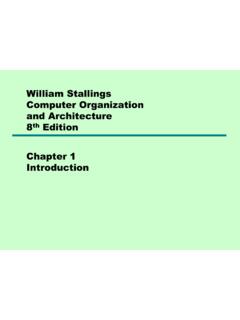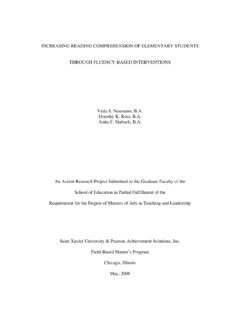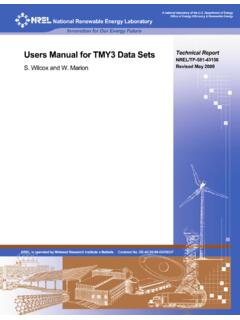Transcription of GCSE Computer Science
1 Revised: November 2013. gcse Computer Science 2013. Geraint D. Jones Mark D. Thomas Disclaimer This resource is provided to support the teaching and learning of gcse Computer Science . The materials provide an introduction to the main concepts of the theory of the subject and should be used in conjunction with other resources and sound classroom teaching. It is intended that the resource will be updated periodically due to the evolving nature of the subject. Suggestions as to how the materials may be developed further are welcome through our feedback system or by sending an e-mail to: resources 2.
2 Contents Computer systems .. 4. Data representation .. 20. Computer system .. 35. Networks .. 43. The Internet and 53. Algorithms .. 62. Programming .. 63. Ethical, social, and legal aspects .. 70. 3. I. Computer systems CAN YOU IDENTIFY AND DESCRIBE Computer SYSTEMS? You should be able to: identify and describe Computer systems: o CPU. o input devices o output devices o backing storage o data bus o address bus o ports and connectivity CPU. ALU. registers controller internal memory The CPU (Central Processing Unit) is the main component in a Computer for processing data and instructions . It could be considered as the computing equivalent of the human brain.
3 It is a hardware device that is made up of many sub components: controller ALU: arithmetic/logic unit registers internal memory buses All of these components have their own specific function. These are discussed in further detail on page 7. 4. Input devices An input device allows data, such as text, images, video or sound, to be entered into a Computer system. Some common hardware input devices are shown below: graphics tablet mouse keyboard microphone Output devices There are many outputs created by a Computer system. These include printed document, on-screen data, sound. An output device allows data to be communicated by the Computer in a human-friendly form, for example, sound being output by a speaker.
4 Some common hardware output devices are shown below: speakers projector monitor printer 5. Backing storage This is where data is stored when it is not being actively used, usually for retrieval at a later date. These are discussed in further detail on pages 15 and 16. Address bus and data bus When data is saved or loaded from memory, the address at which it is to be stored or loaded from must be sent. The storage address of data always travels along an address bus. Data will then need to be moved between several parts of a Computer . The path along which data travels is called a data bus. Ports and connectivity Hardware ports In Computer hardware, a port serves as an interface between the Computer and other computers or devices.
5 Physically, it is a piece of equipment to which a plug or cable connects. An example of different hardware ports can be seen below. HDMI USB USB audio in audio out Software ports Software ports are also used in Computer systems. These are non-physical ports and are completely different from hardware ports. They allow multiple software applications to use different software ports on the same physical connection. Software ports INTERESTING FACT. are discussed in further detail on page 53. In the TCP/IP protocol, the ports are numbered 1 to 65535. Commonly used ports include port 80, for HTTP web access and port 25 for SMTP sending email.
6 6. UNDERSTANDING THE CENTRAL PROCESSING UNIT (CPU). You should be able to: demonstrate an understanding of the Central Processing Unit (CPU), including: o controller o arithmetic and logic unit (ALU). o internal memory o register o buses Components of the CPU: controller, arithmetic and logic unit (ALU), internal memory, registers, buses CPU. ALU. input registers internal controller output device memory device control bus data bus address bus RAM. Controller The controller sends and receives signals from all parts of the Computer . This ensures that all processes take place at the right time and in the correct order.
7 These signals travel along a control bus. Here is an example of a controller in operation: 7. Arithmetic and logic unit (ALU). The ALU is the part of the CPU that processes and manipulates data. It performs simple calculations on the data that is temporarily stored in the registers. Examples of calculations that an ALU might perform are addition and subtraction. The ALU is also able to perform comparisons on data. It is these comparisons that allow programs to make use of choice in a high-level language an IF statement. Registers KEY DEFINITIONS. Controller: manages the execution of instructions A register is a storage location found on the CPU.
8 Where data or control information is temporarily ALU: processes and manipulates data stored. Registers are usually much faster to access Register: fast access temporary data store than internal memory, since they have to be accessed Internal memory: fast access memory on the CPU. so often. Bus: connects different parts of the Computer An accumulator is a common example of a register. This is the register used by the ALU to store the results of its calculations. Internal memory Internal memory (sometimes called level 1 cache memory) is fast access temporary storage on the CPU. Data is moved from the registers to the internal memory when it is not being actively used.
9 Data from internal memory can then either be written to RAM or called back into the registers for further processing. This process of using internal memory speeds up the processing of data. Buses Buses allow data to be transferred to different parts of the Computer . There are three main buses used by the CPU. Two of these, the address bus and the data bus, are discussed on page 4. The third bus is called the control bus. The control bus is used by the controller to send control signals to different parts of the Computer . 8. Explaining the role of the CPU in fetching and executing instructions stored in memory The fetch-decode-execute cycle There are three steps to processing instructions given by a currently running program: 1.
10 The next instruction is fetched from memory into the control unit. 2. This instruction is then decoded to determine the action that needs to be carried out. 3. The instruction is executed. Here is a simplified example of the fetch-decode-execute cycle, where the instruction is to add two numbers: 9. HOW IS PERFORMANCE AFFECTED BY FUNCTIONS? You should be able to: explain how performance is affected by functions, including: o size of cache o speed of clock o number of cores o types of processors Size of cache, speed of clock, number of cores, types of processors Size of cache Cache memory is a fast access type of memory that is very expensive.




